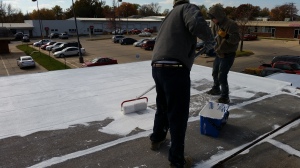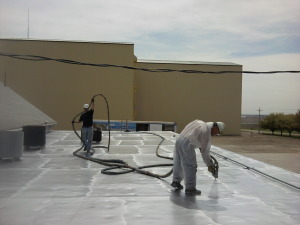Roof Coatings for Commercial Roofs
Roof Coatings for Commercial Roofs: What You Need to Know
When it comes to low-sloped commercial roofs that are leaking, there are two basic ways to fix them: replace the roof or apply a liquid coating to seal in the roof.
While replacement is an effective solution, it has some drawbacks (mainly cost). Removal and replacement of a roof can exceed nearly $10 a square foot. Some other issues include: down time for the building, hazard of debris, adding waste to our ever-increasing landfill problems, etc.
Coatings
Coating processes include many different types of materials ranging from the lower end of acrylics to the best materials such as silicon and polyurea. Like most products you buy, you get what you pay for. While coating commercial roofs can be a great solution, it may not always be the best solution. One of the most common problems we run into with commercial roofing is that the building owners wait too long to repair the roof. The roof is then too damaged to do anything but replace it.
The most important step in using any coating is following the proper prep work to ensure quality and long-lasting roof. This includes proper cleaning. We see a lot of our competitors simply apply the coating over an existing roof without first power washing it. I don’t mean using a small power washer that can be bought at any big box store: I am talking about 3500psi, 5 gallons a minute professional power washer. The coating is only as good as the surface you stick it to. So if the surface is covered with dirt, the coating sticks to dirt. When the dirt falls off then the coating comes off.

The second most important step of coating a roof is using a proper primer. Most coatings require a primer just like painting, making the coating stick better. One area a lot of coating contractors cut corners on is applying the coating at an improper thickness. The thickness is measured in mils or thousands of an inch and it depends on the type of coating. Most coatings are specified dry film thickness (DFT) on at least 15 mils and can range up to over 40 mils. To put this in perspective, standard copy paper is about 8 mils thick. Most acrylic coatings are about 50-60% solids by volume, meaning they are up to 50% water that will evaporate. So if the coatings contractor installs the acrylic at 20 mils wet film thickness (WFT), it dries down to only 10 mils DFT. You lost the majority of the coating.

The pros and cons of various coatings will be discussed in a future blog. For the meantime, if your commercial roof is leaking: call a professional coating company, or just call us!
About the author
Mark grew up in Winterset, Iowa: the birthplace of John Wayne and the home of Madison County Covered Bridges. He lived on a small acreage where they raised cattle, sheep, and chickens. During his youth, he raised and showed cattle with the local 4H program.
Mark’s first paying job was working at the local lumberyard after school and on weekends. After he graduated from Winterset High School he pursued the agricultural field by working on a large farming operation eventually working his way up to the manger position and partner. He also had a long career in the transportation industry.
Mark continues to own and oversee the operations of Iowa Spray Foam in addition to KC Spray Foam & Coatings.
Mark resides in Lee’s Summit, MO with his wife Tina and three of their four children. Their oldest lives and works in the Kansas City area as well.